Last Updated on December 19, 2024 by Owen McGab Enaohwo
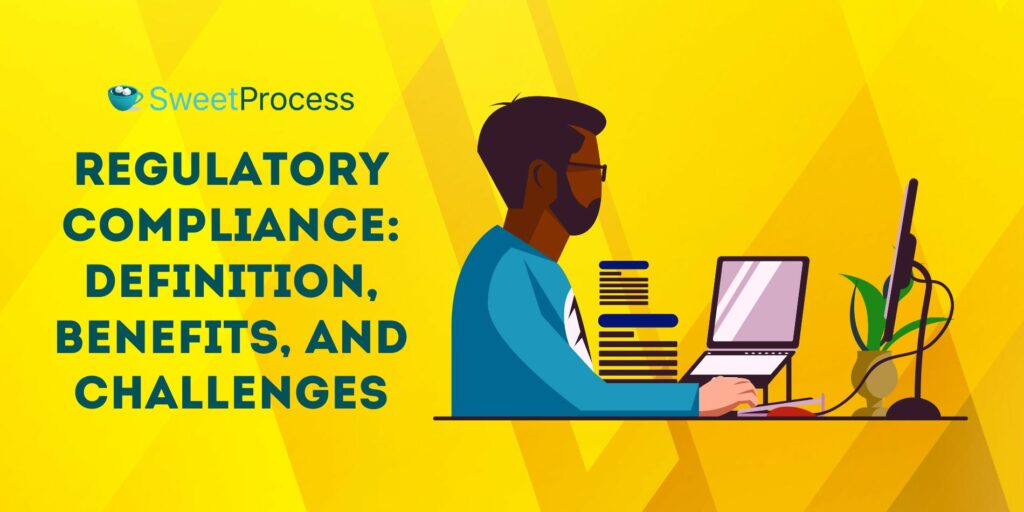
What do data breaches, hefty fines, and tarnished reputations have in common? They’re often the result of failing to comply with industry regulations. Once you receive that notice of non-compliance, it goes beyond just a financial penalty—it’s a blow to your credibility and customer trust.
Regulatory compliance might sound like a tedious box to check, but it’s actually the backbone of a well-functioning business. At its core, it ensures your organization operates within the boundaries of laws and industry standards.
For example, a healthcare provider must adhere to Health Insurance Portability and Accountability Act (HIPAA) regulations to protect patient information. At the same time, a retailer handling online payments must comply with the Payment Card Industry Data Security Standard (PCI DSS) to safeguard customer data.
However, staying compliant isn’t always straightforward. Rules evolve, industries change, and the stakes grow higher. You’ll need to implement policies and adopt tools to manage compliance, whether you are a startup or an established business.
In this article, we’ll demystify regulatory compliance and explore its benefits and challenges to help you thrive.
Managing regulatory compliance doesn’t have to be overwhelming. With SweetProcess, you can streamline your processes and navigate evolving regulations. Sign up for a free trial of SweetProcess now! No credit card is required.
What You’ll Learn In This Guide:
What Is Regulatory Compliance?
Why Is Regulatory Compliance Important?
7 Key Steps to Implement Regulatory Compliance in Your Organization
How to Manage Your Regulatory Compliance with SweetProcess
Regulatory Compliance Examples in Different Industries
Benefits of Regulatory Compliance
Risks Associated With Not Adhering to Regulatory Compliance
What Are the Best Practices to Ensure Regulatory Compliance?
Enhance Your Company’s Regulatory Compliance With SweetProcess
What Is Regulatory Compliance?
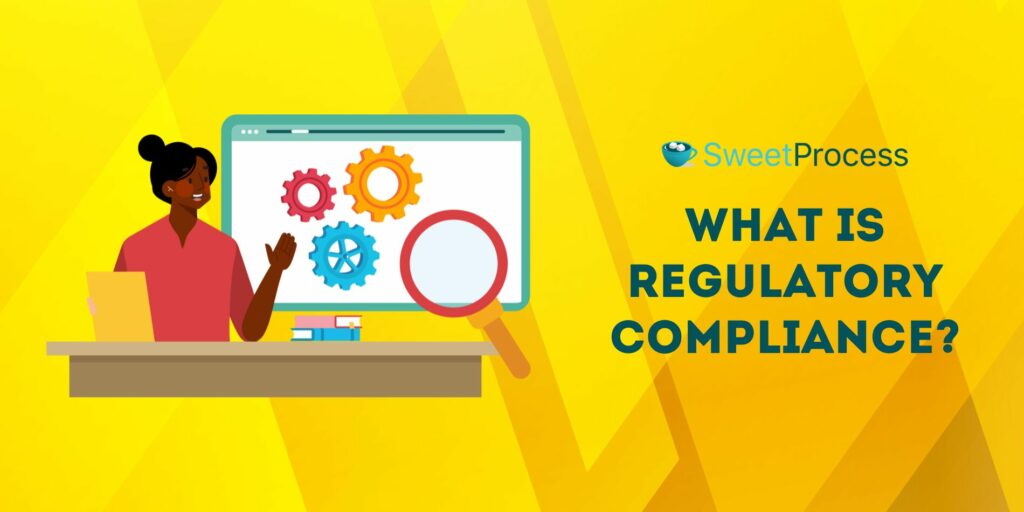
Regulatory compliance involves the relevant processes, policies, and procedures a business follows to ensure it adheres to laws, regulations, and standards that apply to its industry. These rules are designed to maintain fairness, safety, and transparency in business operations, covering areas like:
- Data protection
- Environmental practices
- Financial reporting
- Workplace safety
- Tax laws
- Labor regulations
Compliance is a legal obligation; therefore, organizations try to abide by the set laws to avoid fines and build trust with customers, partners, and regulators. While some regulations cover all sectors, some are industry-specific, and businesses need a compliance management system.
Why Is Regulatory Compliance Important?
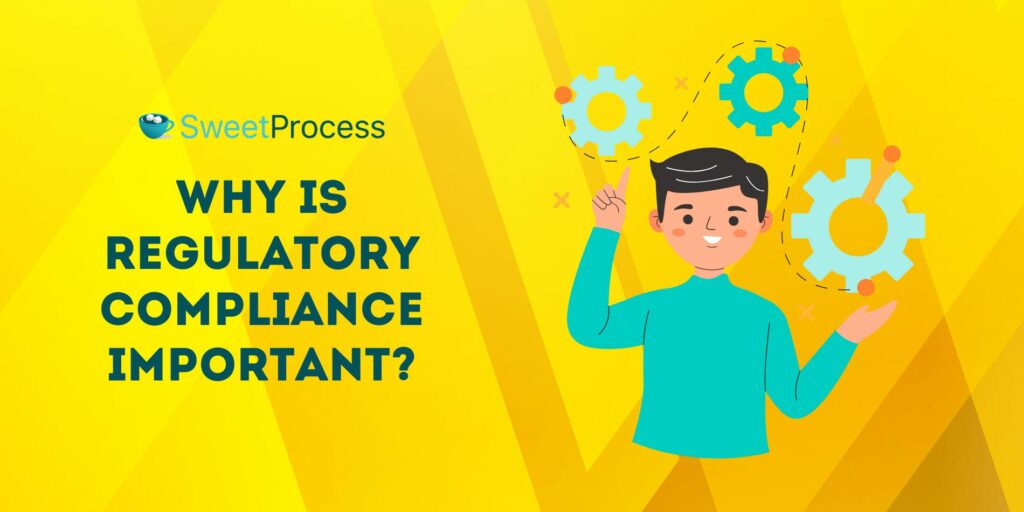
Regulatory compliance is increasingly becoming a focal point for businesses, and for good reason. A 2023 report by Thomson Reuters shows that about 62% of surveyed organizations expanded their compliance departments in recent years.
This growth highlights the rising importance of ensuring businesses meet their regulatory requirements. Let’s dive more into key reasons why compliance should be a priority:
Protect Brand Reputation
A strong brand reputation is invaluable—it attracts customers, investors, and top talent. However, a single compliance breach can tarnish this reputation. For instance, if your company complies with environmental laws, it may attract eco-conscious customers and partners.
Conversely, negative press from compliance failures, such as environmental violations or labor law infractions, is the quickest way to experience boycotts, loss of trust, and public backlash.
Avoid Lawsuits
Legal disputes are time-consuming and costly. Adherence to company policies and procedures could eventually drain your resources, especially if you are sued. For instance, US publicly traded corporations are expected to adhere to the Sarbanes-Oxley Act (SOX), a federal law enacted to protect investors from fraudulent financial practices.
A company is considered non-compliant with SOX when it misrepresents its financial reports to mislead investors. Several companies have incurred massive legal and financial penalties for violating these regulations.
Compliance reduces this risk by ensuring your organization maintains financial integrity.
Safeguard Financial Security
You don’t want to spend your company’s profits paying hefty fines and penalties. It’s much better to comply with the governing accounting practices and tax laws that can result in severe financial consequences that can negatively impact your business.
Beyond fines, non-compliance can also lead to lost business opportunities and reduced investor confidence, especially if your business loses its credibility.
Maintain Business Continuity
Imagine closing down your startup because of a compliance issue. That would be so disappointing, especially since it can be avoided.
Non-compliance can disrupt operations, sometimes to the point of threatening a company’s existence. Regulatory authorities may revoke licenses, impose shutdowns, initiate product recalls, or restrict operations, causing significant downtime and revenue loss.
However, when you are compliant, your business is prepared to face audits or inspections without interruptions.
Defend Against Data Theft and Cyber Attacks
According to a 2023 IBM report, the average cost of a data breach hit $4.45 million globally—a 15% increase in the past three years. Such high costs can be expensive for your business, especially since data breaches have become a growing threat as the business world relies more on technology.
Regulatory compliance mandates organizations adopt cybersecurity measures and data protection regulations, such as the General Data Protection Regulation (GDPR) or California Consumer Privacy Act (CCPA), to protect sensitive information and safeguard data.
7 Key Steps to Implement Regulatory Compliance in Your Organization
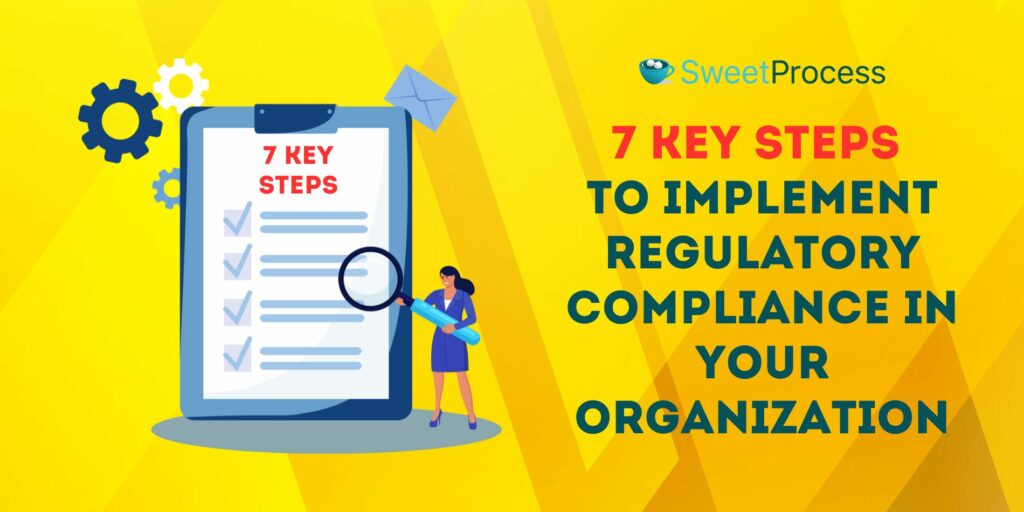
Achieving regulatory compliance may seem challenging, but breaking it into manageable steps can simplify the process. Here’s a roadmap to help your business implement compliance effectively:
Identify Which Regulations Apply to Your Business
If your business operates in multiple locations, you’ll need to familiarize yourself with the regulations you must follow.
For instance, if you run a fintech company, you may need to comply with PCI DSS for payment security, GDPR for handling EU customer data, and anti-money laundering (AML) laws if operating globally. Each of these applicable laws has unique requirements that you must understand.
Keep in mind that the regulations will vary depending on your industry, location, and size. You can consult with legal counsel or regulatory agencies to identify the relevant ones and stay prepared.
Conduct a Functional Gap Analysis
Once you identify the regulations, the next step is to evaluate how your current processes align with them. A functional gap analysis helps pinpoint areas of weakness or non-compliance, serving as a foundation for building an actionable compliance plan.
For instance, a logistics company might find through a gap analysis that its fleet tracking system lacks the data reporting capabilities required by emissions regulations. Once you identify this gap, you can make necessary adjustments to avoid facing penalties.
Pick the Right Compliance Tool
Industries such as banking are leveraging technologies like cloud computing and big data for compliance monitoring and testing. In the same way, your business needs compliance tools that make adherence more efficient.
For instance, if you adopt compliance or policy management software, you can write policies, document processes, track progress, and generate reports to meet regulatory requirements. In addition, you can automate repetitive compliance tasks, which reduces errors.
Train Your Employees
Regulations constantly change, making it difficult for your employees to keep up. You must ensure that all team members are fully aware of the relevant regulations, their responsibilities, and non-compliance repercussions.
With the help of a compliance tool, you can effectively train employees to understand key distinctions, such as the difference between policy and process and policy and procedure. Regular training sessions can motivate employees to comply and address potential risks immediately.
Appoint a Compliance Officer
As the business owner, CEO, or founder, you might need more time to follow up with every activity. Delegating this role to a chief compliance officer significantly boosts accountability. This individual is the primary point of contact for regulatory updates, audits, and incident management.
They are also responsible for aligning company practices with the latest laws. This strategy lets you focus on other key roles while the compliance officer handles policies.
Set up Monitoring
Compliance is not a one-time task—it requires continuous monitoring. For this, you’ll need an active tracking system that helps you identify issues early, allowing for timely corrective action before problems escalate.
While you have a compliance officer, you can reinforce the monitoring process by adopting an automated tool.
Conduct an Internal Audit
Most businesses hire external auditors to review their finances and operations. But before these external regulators step in, you should conduct internal audits to evaluate your compliance processes and identify gaps. For instance, you can plan quarterly audits to confirm that you are still on track.
This approach keeps your organization prepared and improves accountability to avoid future disruptions.
How to Manage Your Regulatory Compliance with SweetProcess

What if you had a tool to manage your policies, procedures, and processes seamlessly in a centralized location? SweetProcess does exactly that. With this software, you can create a knowledge base and leverage AI tools for documentation and team collaboration to help your business stay compliant.
In this section, we’ll walk you through practical steps to streamline your compliance efforts using SweetProcess.
How to Write Your Company’s Policies Manually Using SweetProcess
SweetProcess provides a structured platform to create policies that keep you compliant. Here’s how to go about it:
- Log in to your SweetProcess account and select “More” on the main menu.

- Click “Policies.”

- Select “Create Policy.”

- Add a name for the policy.

- At this point, you can assign the policy to the specific teams and tap “Continue.”

- Edit the policy on the next page and save the changes.
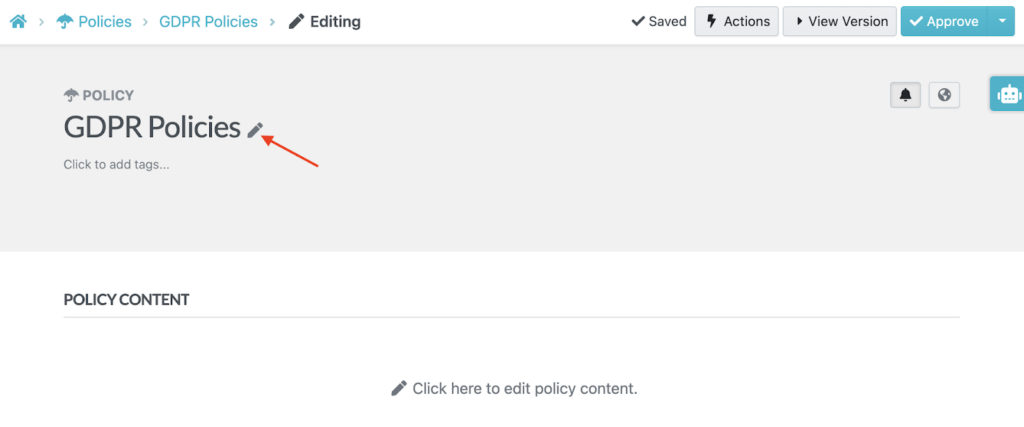
How to Document Your Company’s Policies Using AI on SweetProcess
AI tools can accelerate policy documentation, especially for businesses managing large volumes of information. SweetProcess simplifies this process. Here’s how to write a policy using AI on SweetProcess.
- Use the same steps as listed above to create a new policy.
- However, once you include the policy title, select “Write with SweetAI.”

- SweetAI will generate this content within a few minutes.
- You can then use the pencil icons to make edits. Add tags to make it easier to find your policy.
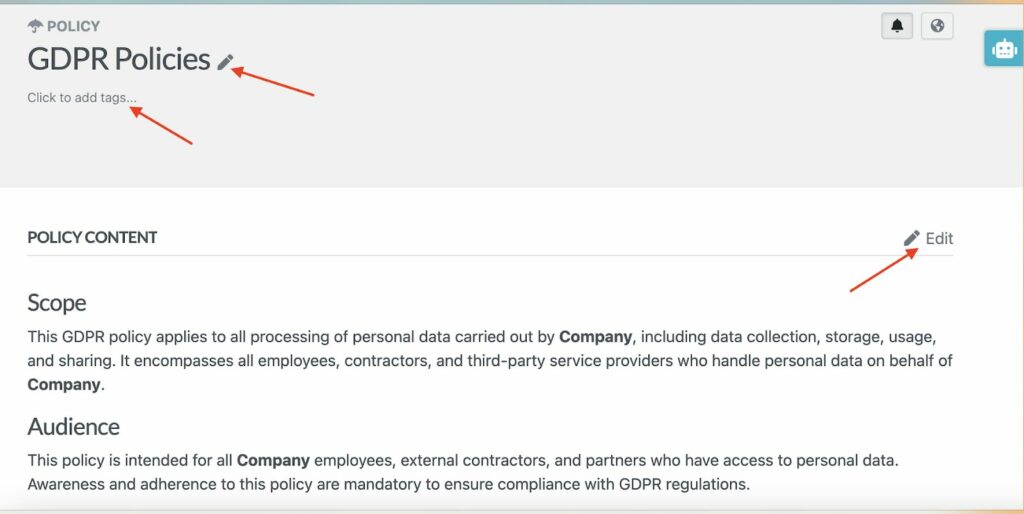
- Save the changes.
How to Manage Your Company’s Policies in One Place on SweetProcess
Keeping policies scattered across multiple platforms can lead to miscommunication and errors.
SweetProcess allows you to centralize policy management for easy access and updates. Here’s how:
- Go to the “Policies” section. Here, you’ll see a list of all your policies.
- You can edit, duplicate, share, export, or delete the policy from here. Click on the three dots on the right and pick an action.
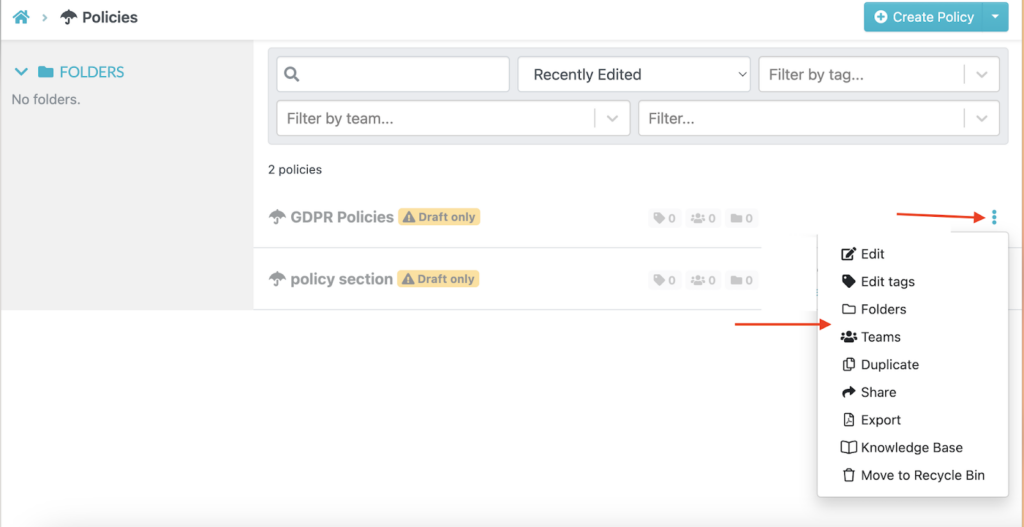
How to Create an Internal and External Knowledge Base on SweetProcess
A well-maintained knowledge base informs your employees and clients on all policies, processes, and procedures. To create a knowledge base on SweetProcess, follow these steps:
- Click the “More” button.
- Select “Knowledge Base.”
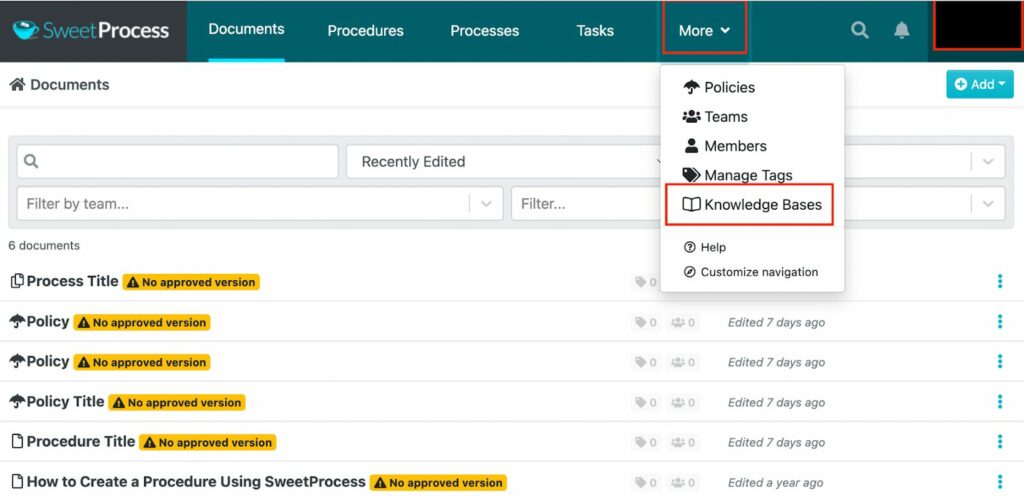
- Select the “Create Knowledge Base” button.

- Add a title for your knowledge base and click “Continue.”

- Click the pencil icon to edit and add details to your knowledge base.
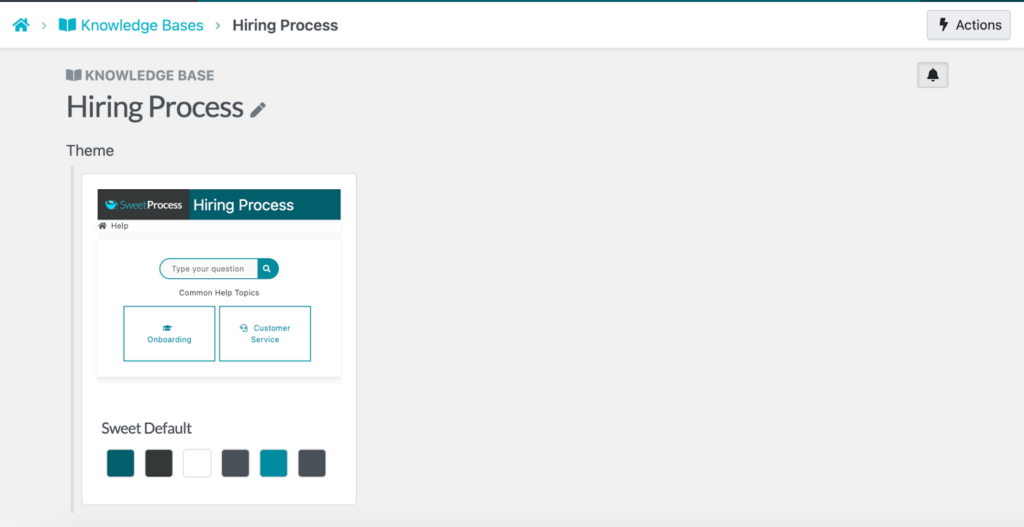
If the knowledge base is for external stakeholders, scroll down to the control access section and choose the public option.

Alternatively, if it’s for internal use, click the drop-down button to select the private knowledge base option.

Add the knowledge URL to complete the setup process.
How to Document and Manage Your Company’s Procedures and Processes on SweetProcess
Procedures and processes are vital to compliance. SweetProcess ensures these are documented and managed effectively.
To create and manage your company procedures, follow these steps:
- Go to the “Procedures” tab on the main menu and select “Create Procedure.”

- Add a procedure title.

- Add tags, videos, and images that are part of the procedure and then assign it to the respective teams.
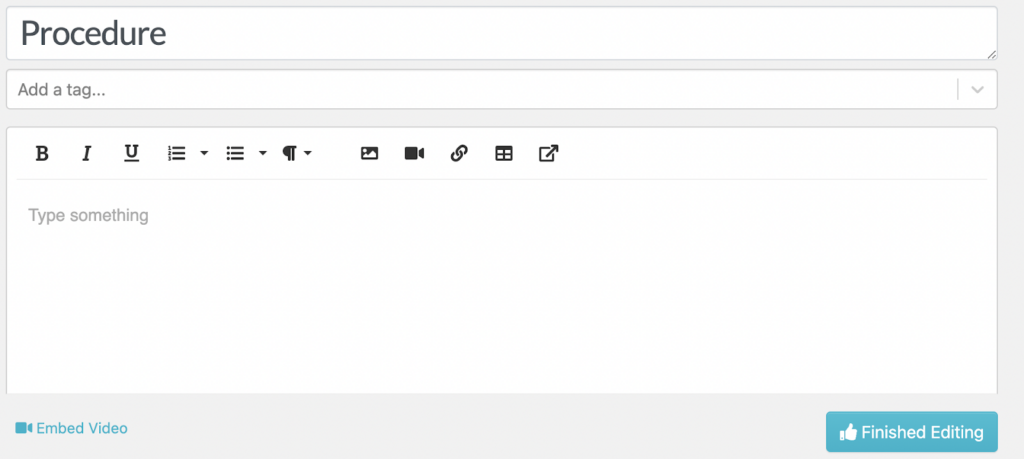
Instead of drafting the procedure manually, you can write it using SweetAI.
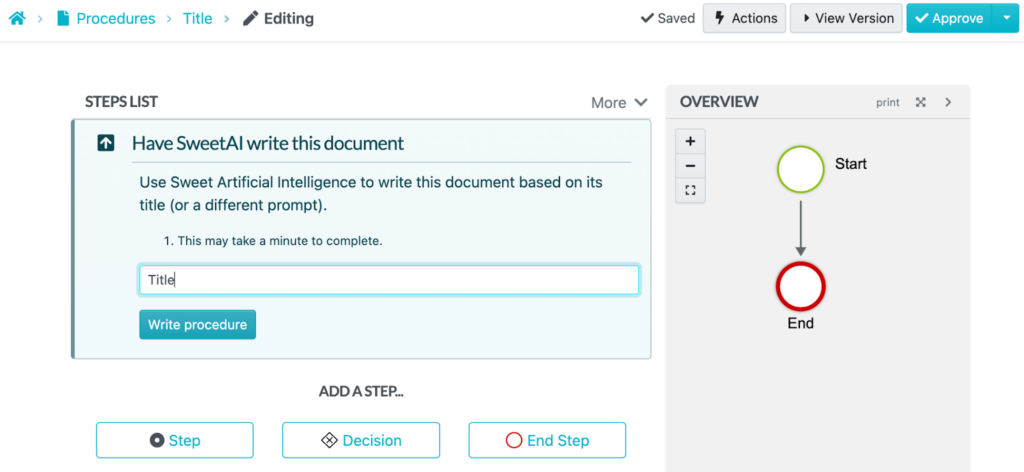
On the other hand, you can follow similar steps to document your processes.
- Select “Processes” and click “Create Process.”

- Add the process title.
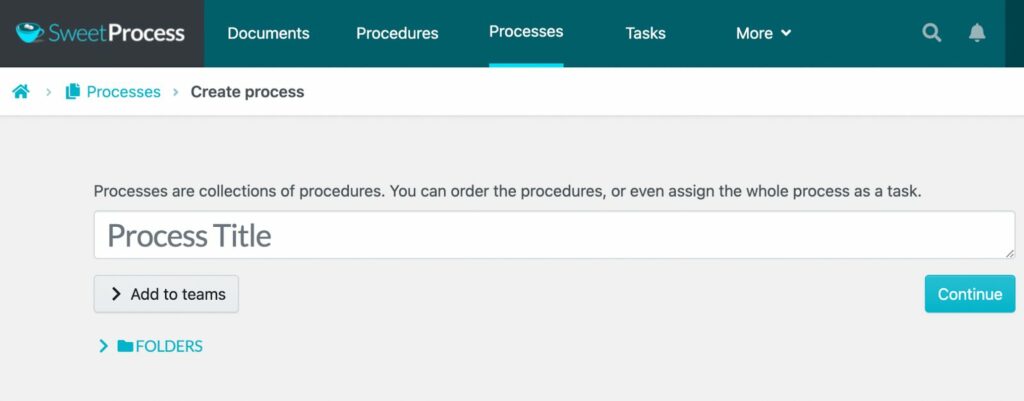
- Add details, including images, videos, and tables, to make your process comprehensive.
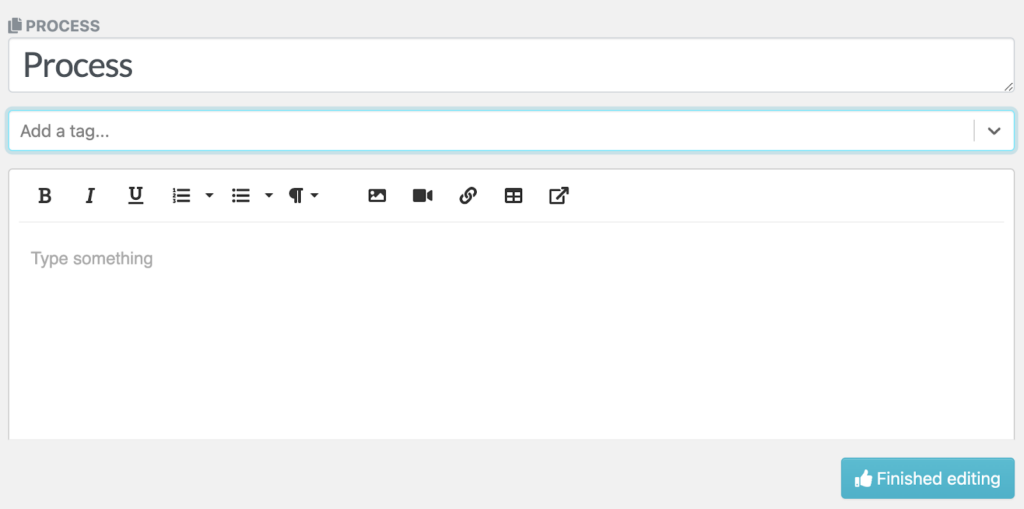
Save the process to make it accessible.
SweetProcess offers search capabilities that make finding a process or procedure easy. From the dashboard, you can find the document you need to edit, share, export, or delete.

Collaborate With Team Members and External Stakeholders on SweetProcess
For the company to be compliant, all stakeholders must be on the same page. Collaboration is an important part of this. SweetProcess makes this possible by providing a platform to assign and manage tasks.
Here’s how to assign these tasks:
- Select the “Tasks” button on the dashboard.
- Click “Assign Tasks.”

Assign the tasks to specific team members. For better tracking, you can add the employee’s name, task name, and due date.
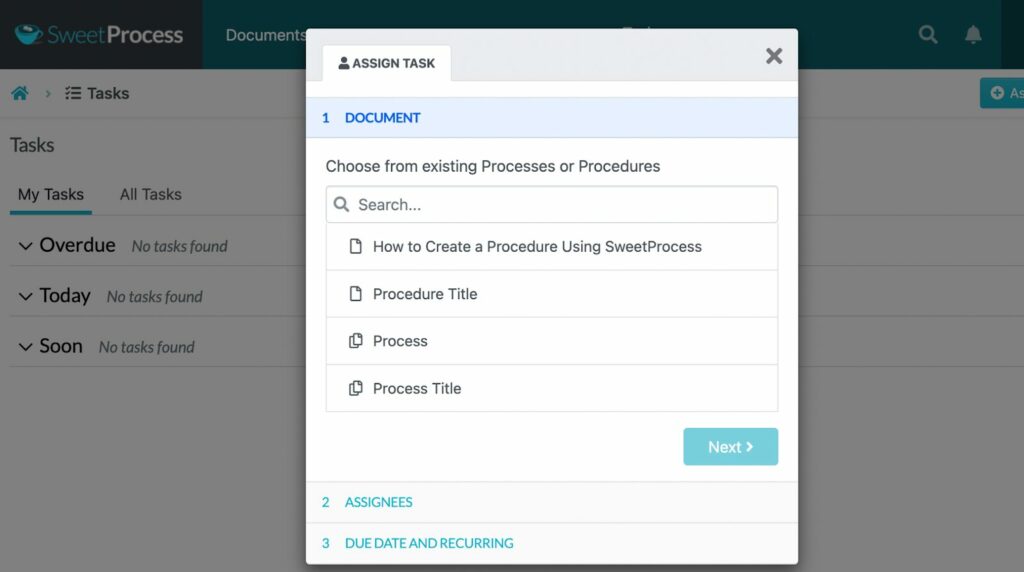
Select “All Tasks” to view all tasks. The filters make it easy to search for what you need.

Additionally, you can share a process, policy, or procedure with team members from the dashboard. Select “Documents” and choose what you need.
Click on the three dots on the right and select “Share.”
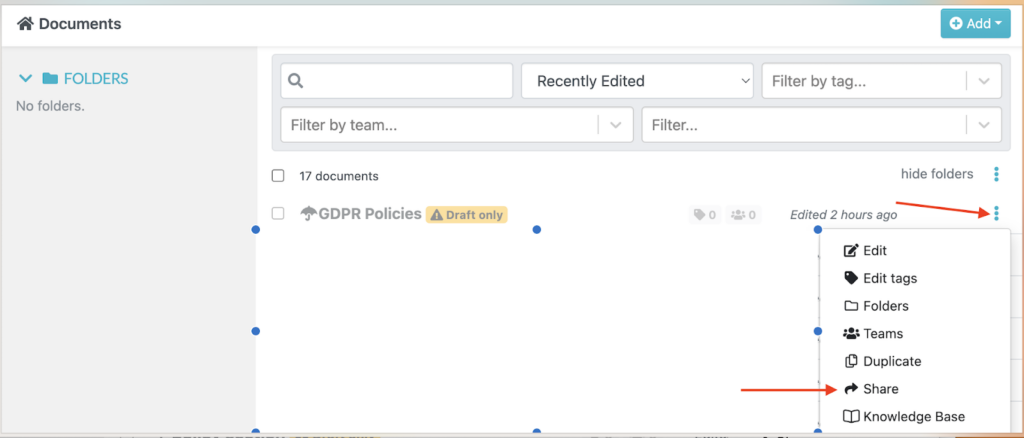
Here are some companies that have used SweetProcess to manage their policies and procedures.
Stone & Wood faced significant challenges managing their operations, relying on binders and Word documents for process documentation. This system led to inconsistencies, delays, and compliance risks due to outdated procedures and limited visibility into employee adherence.
Additionally, onboarding and training employees was inefficient and time-consuming, especially for short-term roles. Recognizing the need for a better solution, Tom, the quality assurance and sensory coordinator, explored various tools and found SweetProcess ideal for its ease of use and flexibility.
Since the company started using SweetProcess, they have achieved these benefits:
- Streamlined employee onboarding and training: Managers can now effortlessly track progress and create safety and quality inductions that new hires can complete at their own pace.
- Efficient updates to processes: The mobile-friendly platform allows updates to be made instantly on the production floor, saving time and reducing errors.
- Centralized knowledge base: SweetProcess created a single source of truth for employees to access critical information, with features like sign-offs ensuring accountability.
- Regulatory compliance: The company now complies with standards like ISO certification by showcasing employee training and updated procedure documentation, meeting regulatory requirements.
Another company that has benefitted from SweetProcess is DFK Hirn Newey, a financial and professional services firm. Initially, the organization faced significant challenges with technological overload and communication inefficiencies. The rapid adoption of new software caused resistance among staff, inconsistent documentation, and compliance issues.
Director Paul Fiumara, determined to modernize operations, discovered SweetProcess while searching for a cloud-based solution to streamline procedures and integrate their tech stack. By implementing SweetProcess, the company:
- Simplified documentation of procedures and policies, reducing the burden on staff.
- Created a notice board for key updates, reducing excessive emails and improving communication.
- Ensured compliance with professional standards, securing the highest possible certification ranking.
- Streamlined onboarding for new employees by providing a central hub for organizational procedures.
- Freed up leadership to focus on high-level tasks instead of constant crisis management.
Regulatory Compliance Examples in Different Industries
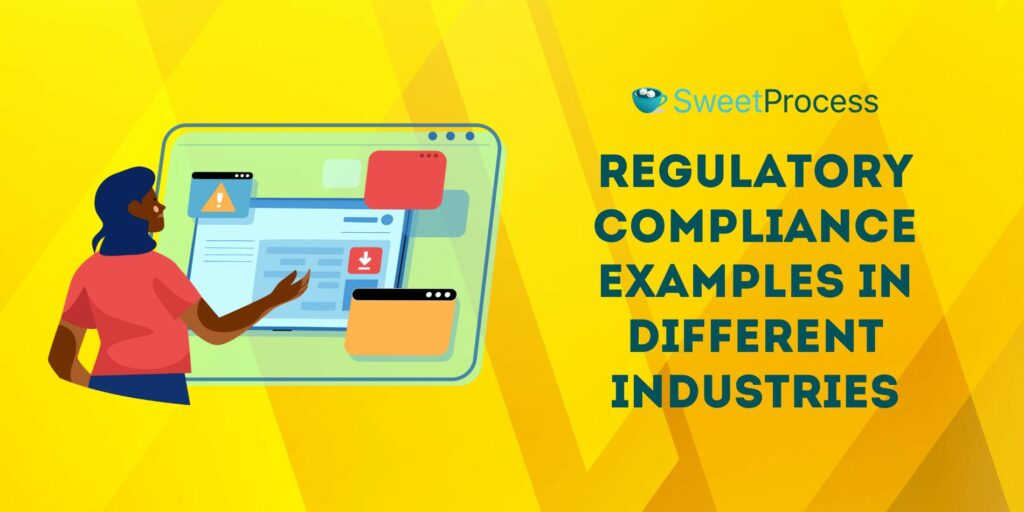
Most industries are governed by specific regulations that ensure they operate within legal frameworks. Here’s how regulatory compliance plays out in various sectors:
Regulatory Compliance in Business
If you operate a business, you must adhere to local, national, and international regulations to operate legally and ethically. These include taxation, employment, data protection, environmental regulations, and corporate governance laws.
For example, companies in the EU must comply with the General Data Protection Regulation (GDPR) to protect customer data and avoid hefty fines.
Regulatory Compliance in Manufacturing
The manufacturing industry is subject to various regulations, including:
- Product safety regulations to ensure that products are safe for consumers and comply with safety standards.
- Environmental laws that regulate emissions and waste management.
- Labor regulations governing working conditions and worker safety.
Standards like the Occupational Safety and Health Administration (OSHA) in the US mandate workplace safety protocols. An example is the ISO 14001 certification, which focuses on environmental management systems.
Regulatory Compliance in Banking
Your bank policies and procedures help you stay compliant with industry regulations. Due to the rising cases of fraud and identity theft, banks are expected to have strict compliance measures in place. These requirements protect customers and financial systems.
Some of the common regulations in this industry include:
- Anti-money laundering (AML) measures
- Know Your Customer (KYC) protocols
- Compliance with the Dodd-Frank Act in the US was introduced to make the financial system safer.
For instance, banks use KYC processes to verify customer identities and prevent fraud.
Regulatory Compliance in the Pharmaceutical Industry
As one of the most critical industries, the pharmaceutical industry is governed by strict regulations to ensure the safety and efficacy of drugs.
Agencies like the Food and Drug Authority (FDA) (US) and the European Medicines Agency (EMA) (Europe) oversee clinical trials, manufacturing, and marketing. Quality standards like Good Manufacturing Practices (GMP) also ensure that medications are produced consistently and meet quality standards.
Regulatory Compliance in Cyber Security
There are thousands of cyber attack cases and attempts every year. Because of this, the cybersecurity industry constantly introduces and revises regulations that require businesses to protect sensitive information and implement strong security measures.
Here are some good examples:
- GDPR: This European Union law governs the processing of personal data. It provides guidelines for data protection and breach response.
- HIPAA: This US law governs the privacy and security of health information.
- PCI DSS: These are security standards for organizations that handle credit card information.
Regulatory Compliance in the Automotive Industry
Like most sectors, the automotive sector faces regulations for vehicle safety, emissions, and consumer protection. Standards like the National Highway Traffic Safety Administration (NHTSA) in the US ensure vehicle safety, while environmental laws like the Clean Air Act regulate emissions.
Automakers must comply with these standards to launch products in global markets.
Regulatory Compliance in Insurance
According to data, the total cost of non-health insurance fraud is approximately more than $40 billion annually. The industry is heavily regulated to protect consumers and ensure insurers’ financial stability.
A good example is the adherence to solvency requirements set by the US National Association of Insurance Commissioners (NAIC). With this legal requirement, insurers must maintain adequate capital reserves to meet their obligations.
In addition, insurers must comply with consumer protection laws that govern insurance sales practices and claims handling.
Regulatory Compliance in Healthcare
Healthcare providers and institutions follow strict regulations to protect patient privacy and ensure quality care.
The Health Insurance Portability and Accountability Act (HIPAA) in the US governs the protection of patient information. Healthcare organizations must implement secure systems to store and transmit patient records. Additionally, state licensing laws dictate that healthcare providers must be licensed by the state where they practice.
Benefits of Regulatory Compliance
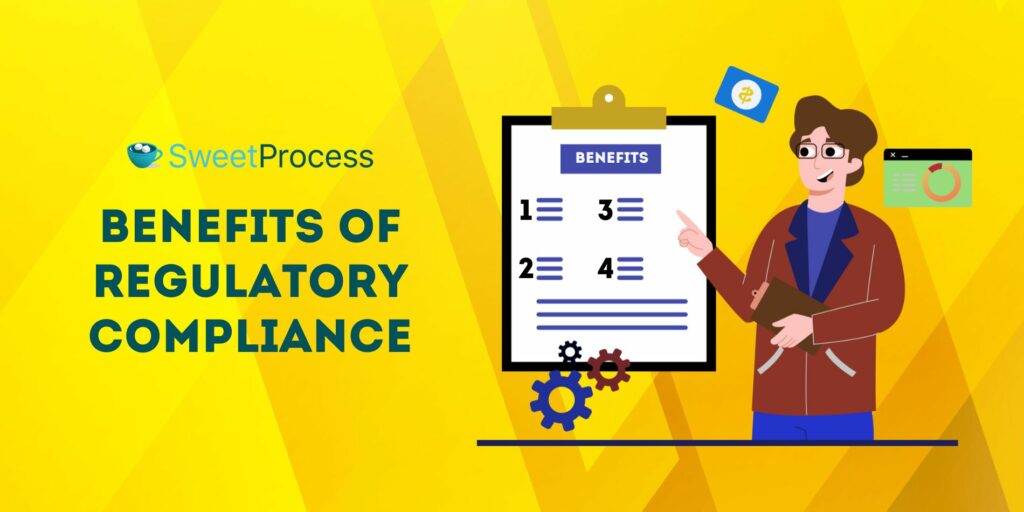
While most businesses adhere to regulatory compliance to primarily avoid penalties, there are more benefits that could strengthen your operations. Let’s explore these benefits:
Reduced Risk and Liability
Imagine how expensive it would be for your company to keep paying fines from back-to-back lawsuits. As a business owner, you can avoid this by ensuring your organization is always compliant. This way, you identify and mitigate risks before they become uncontrollable. You can also address potential hazards early to minimize your exposure to lawsuits and financial penalties.
Improved Operational Efficiency
Company operations are affected when critical areas fail. For instance, if your manufacturing plant fails to comply with standards to maintain product quality, you’ll start missing out on sales, losing customers to your competition, and eventually making losses.
Following industry best practices does the opposite. Your team will be more efficient because they know the standardized processes they need to follow, which improves the quality of your products and services. These regulations help eliminate inefficiencies across all departments, which is good for your bottom line.
Safeguard Stakeholders
Think of your customers, employees, and investors. Why are they loyal to your business? You must be doing something right. Compliance with the different labor laws, environmental regulations, and data privacy laws signals that you value their connection to your business.
You can create a safe and ethical working environment for your employees to reduce injury rates. On the other hand, the customers expect you to maintain quality standards and protect their data. In the long run, this approach reassures your investors about the company’s commitment and strengthens the relationship.
Strengthen Company Reputation
You’ve already seen what happens to financial institutions and banks that have encountered data breaches. Their reputations suffer, as customers can’t trust that their information and money are safe.
You can enhance your brand reputation by consistently complying with regulations and staying committed to ethical business practices and social responsibility. Customers and investors gravitate toward organizations that prioritize these standards.
Data Breach Protection and Privacy
A data breach report shows a 78% increase in data compromised between 2022 and 2023. The increasing cybersecurity threats require businesses to prioritize data privacy regulations and compliance.
Adhering to regulatory frameworks like GDPR and CCPA can protect sensitive data. Reassuring customers that their personal information is always safe can also prevent the associated reputational and financial damage.
Avoiding Unnecessary Legal Issues
Non-compliance leads to multiple legal issues, including investigations, audits, and lawsuits. They also take up time and resources that you can use to focus on your business. Regulatory compliance allows you to navigate legal challenges and protect your business.
For example, when you follow ethical workplace standards and enforce safety measures in the facilities, you reduce the risks of injury for your employees; therefore, you won’t be sued.
Fostering Healthy Competition
Regulations often level the playing field by setting industry compliance standards that all businesses must follow. Companies can compete fairly, prioritizing quality, innovation, and customer satisfaction. For instance, antitrust regulations prevent monopolies, encouraging smaller players to thrive in the same market.
Compliance also encourages businesses to excel ethically rather than resorting to shortcuts that give them a competitive advantage.
Risks Associated With Not Adhering to Regulatory Compliance
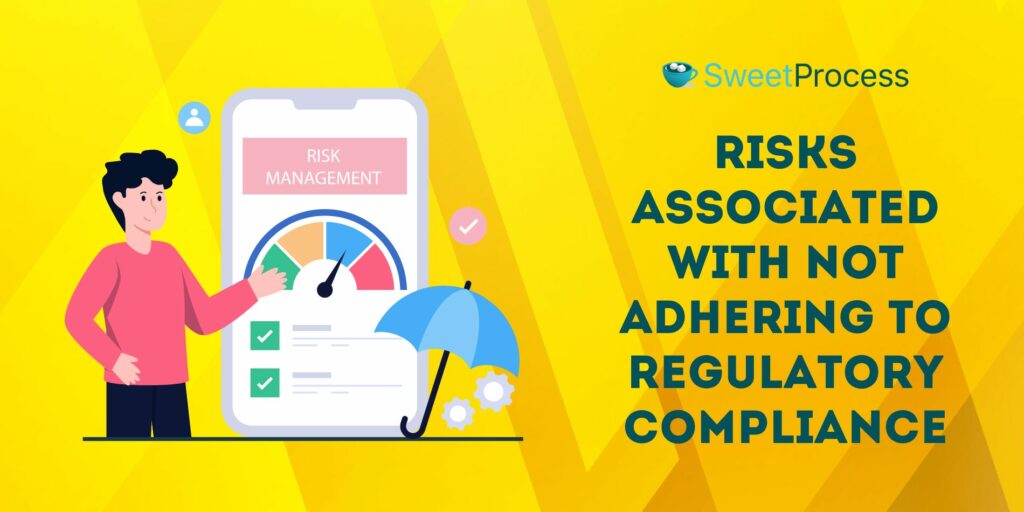
So what happens when you fail to comply with the regulatory requirements we’ve mentioned? Here are the risks you could be exposing your business to:
Impact on Business Operations
Once your manufacturing company fails safety inspection or your pharmaceutical facility ignores FDA regulations, it could lead to significant operational disruptions. Regulatory agencies may mandate immediate shutdowns until compliance is achieved; therefore, you have to halt production and delay crucial projects.
This creates a domino effect—orders go unfulfilled, customers turn to competitors, and contractual obligations are left unmet. After such hiccups, your business may not get back on its feet or take longer to get everything operational.
Legal Liability
Non-compliance exposes your organization to lawsuits from government bodies, customers, or other entities. For instance, residents can sue you for environmental pollution if your business is not following the set regulations, or customers can file a lawsuit when their data is leaked due to a data breach.
These legal challenges will divert your resources and focus from other strategic initiatives. Additionally, they have severe financial consequences in case the company is fined, which affects your revenue.
Loss of Licensing or Authorization
Most sectors require specific licenses for your business to operate. For instance, as a healthcare provider, you must follow the safety standards and HIPAA regulations or risk losing your medical license.
If your business fails to acquire these authorizations, you might get suspended, eventually affecting the business operations.
Financial Penalties
One of the largest banks in the US, Wells Fargo, was ordered by the Consumer Financial Protection Bureau (CFPB) to pay over $2 billion to their customers and a $1.7 billion penalty as redress for legal violations. This case is a good example of regulatory bodies imposing hefty fines for non-compliance.
Any form of illegal conduct that violates the laws could impact your bottom line, especially as a small or medium-sized business. You must spend money on legal defense and mediation, which eats into your budget.
Reputation Losses
Bad publicity can quickly ruin a company’s reputation. For instance, a food company violating health standards could face widespread boycotts and social media backlash, slowing down sales.
A damaged reputation makes it harder for customers to trust your product and services ever again. You might also lose partners and investors, which has long-lasting consequences, such as business closure.
What Are the Best Practices to Ensure Regulatory Compliance?
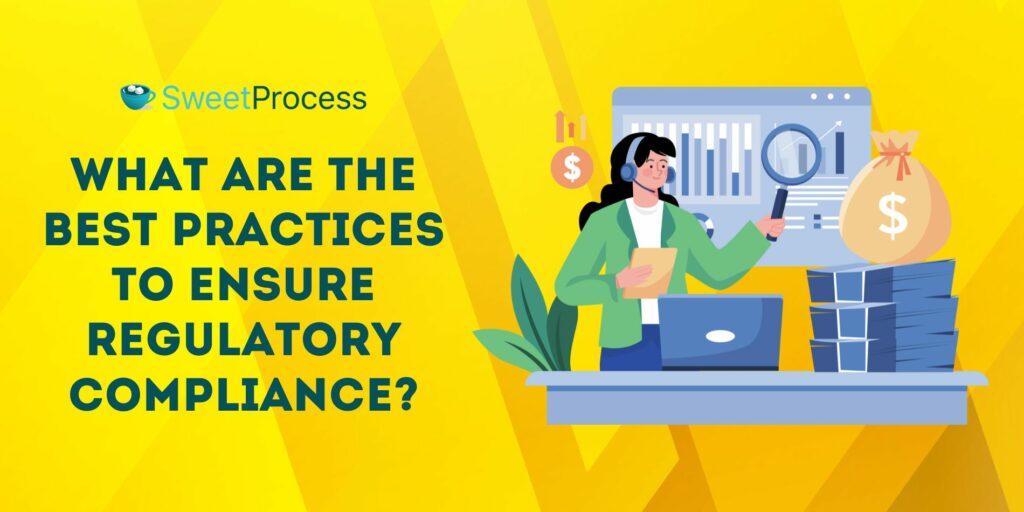
Although several business regulations exist, you can effectively comply with them with the right tools. Here are some best practices to help you navigate:
Identify Regulations and Risks
As we’ve mentioned, regulations vary depending on the industry. They also differ based on your locality; therefore, as a business owner, you must know the federal, state, and local laws that apply to your company.
Once you have identified the relevant regulations, you can assess the potential risks associated with non-compliance. This risk assessment will help you prioritize compliance efforts and allocate resources accordingly.
Design a Compliance Plan
Like other business requirements, you need a compliance plan to guide you. In this plan, you can include:
- The specific steps your company will take to meet regulatory requirements.
- The policies, processes, and procedures you need.
- Responsibility allocation for easier management.
- A monitoring and reporting system to track progress.
With a well-structured plan, you can provide clarity to your team members and reduce the likelihood of costly errors.
Start With Your Highest Priorities
What regulations pose the highest risk to your business?
This question should guide you in prioritizing the most critical regulations and high-risk areas. For instance, compliance demands for a bank can be quite overwhelming. In this case, you might first start with the KYV requirements to avoid legal penalties, then move on to updating fraud detection software.
In your compliance plan, you can indicate the issues that the organization needs to address immediately before tackling less pressing issues.
Provide Your Employees With Regulatory Compliance Training
New regulations are introduced every year, and businesses must adhere to them. Your employees need to be updated on these changes. Regular training ensures that employees understand the regulations affecting their roles and how to follow established procedures.
You should organize sessions for new hires and refresher courses to reinforce a culture of compliance. Well-trained staff are less likely to make costly mistakes, which protects your business.
Use Regulatory Compliance Software
Even though your team is now trained, they still need tools to automate processes. Manual tasks can be simplified by adopting regulatory compliance software. These tools manage complex compliance requirements by centralizing data, automating processes, and tracking updates.
In addition, you can use the compliance software to streamline documentation, especially critical policies that keep your business compliant. When new regulations are introduced, they can be updated on the software and made accessible to every team member, which makes training easier.
Common Challenges of Regulatory Compliance in an Organization
Why do most businesses have a challenge being compliant? In this section, we’ll examine the common challenges to help you better prepare and implement effective strategies to overcome them.
Lack of Awareness and Understanding
It’s common for business owners and employees to be unaware of regulatory requirements. Even when they are aware, some misunderstand their applications, leading to non-compliance.
As a small business, you might overlook local tax laws or industry-specific regulations, putting your company at risk. Additionally, if you haven’t trained or communicated the regulations, your employees may not be aware of the specific regulations that apply to their roles.
Resource Limitations
Compliance is resource-intensive. Your compliance program needs financial investment, dedicated personnel, and time to run efficiently. Smaller organizations may struggle to allocate the necessary resources, leading to gaps in compliance measures.
For instance, as a startup, you might not have the budget to hire compliance officers or invest in software solutions, making it challenging to keep up with data privacy regulations like GDPR compliance. This challenge calls for proper planning and prioritizing critical compliance areas.
Siloed Information and Processes
Are your departments communicating? Is every employee aware of their responsibilities when it comes to compliance?
If all your compliance efforts and information are fragmented across different departments, you increase your chances of missing requirements. Silos make it difficult to maintain consistency, share updates about regulations, or conduct thorough audits. Centralizing compliance data between teams will improve accountability.
Complexity and Dynamism
Most regulations change regularly and are explained in complex legal language. Companies that operate in different jurisdictions must also stay updated on new rules for each location. This complexity makes it easy to miss critical requirements that could disrupt operations.
This is why businesses need a robust monitoring system to track changes. You can also consult legal experts to help your organization avoid problems.
Enhance Your Company’s Regulatory Compliance With SweetProcess
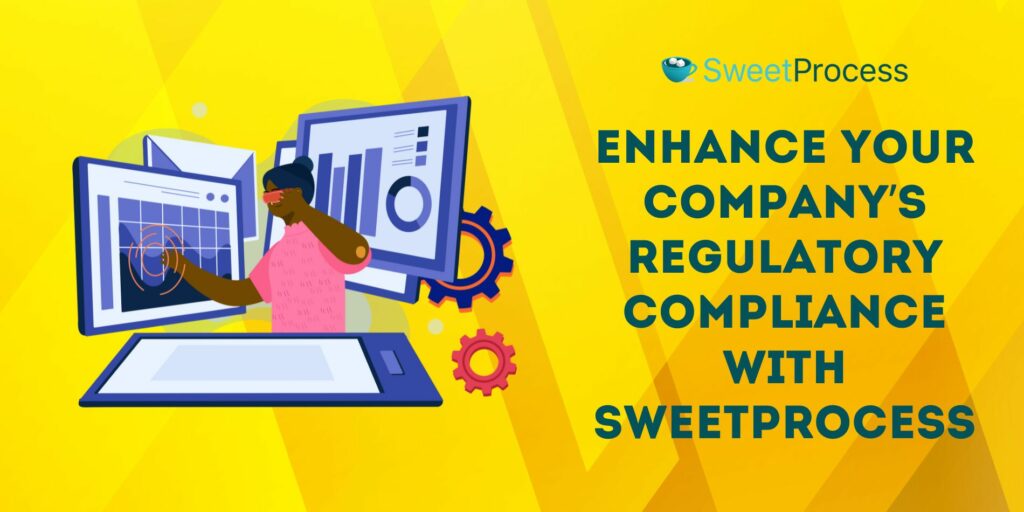
Regulatory compliance goes beyond meeting basic requirements—it’s the foundation of your company’s success, trustworthiness, and long-term growth. Adhering to these regulations reduces risks for your business, prevents legal issues, and builds your reputation among stakeholders. However, with the ever-changing regulations, staying compliant can feel like an uphill battle.
That’s where SweetProcess comes in. Our software simplifies regulatory compliance by centralizing workflows, streamlining documentation, and ensuring every team member is aligned.
With features like task management, policy creation, and real-time updates, SweetProcess equips you with the tools to tackle compliance challenges and adapt to regulatory changes.

